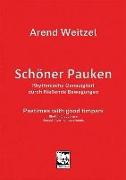- Start
- Schöner Pauken
Schöner Pauken
Angebote / Angebote:
When we play timpani, we produce our sounds through the movements of our hands
and arms. When we strive for rhythmic precision, we should therefore accordingly
organize and give structure to these motions. But what does that mean? How can
movements be executed, in order for them to be favourable for precision?
When single movements are constantly repeated without interruption, they develop
into regular cyclical motion sequences. And since they are so uniform and predictable,
they are particularly suitable for our purposes.
Examples of cyclical motion sequences are familiar to us through walking, when we
want to get from point A to point B. Once we get started, the movements always follow
the same patterns, largely automatically. It's not necessary to consciously command
the individual steps. The size and speed of our steps change only through a conscious
decision on our part. This autonomy and independence of movement has the
advantage that we can do other things simultaneously: we can chat, converse, do
something with our hands at the same time, etc.. However, this independence of
regularity is by no means reserved just to our feet and legs. Through evolution (formerly
we were four-legged!) our hands and arms are fundamentally capable of doing this
too.
For example, if I play a flowing continuous series of strokes with one hand, I'm not
actually thinking about things like tempo, rhythm, meter etc. Regardless of the
necessary acoustic control of what is happening, it is particularly important for me to
feel the regularity of movement, which I perceive in various ways:
. by the same constant size of movement
. by the same constant speed of movement
. by the same constant activity of the muscles involved
. by the same constant "answer" (rebound) from the vibration of the skin
Here too, these strokes become more or less independent, so in turn this gives me the
opportunity to do something completely different with the other hand. And that is a
good thing, because we shouldn't be doing incessantly the exact same strokes. With
regard to the rhythmic accuracy that we are aiming for, our challenge is now to retain
as much of our steadiness and reliability as possible, even when playing more complex
rhythms. The more the individual movements are combined to achieve a continuous
flow of movement, and the better the movements of each hand interlock, the calmer
and more predictable the movements become. Obviously this has an immediate effect
on your rhythmic steadiness. Ideally, a feeling could arise here that some people may
know from juggling: an automatic and perpetual interlocking of activities of both hands,
that never seems to stop and is by the way a lot of fun! The fact that the whole process
also has a positive effect on your sound is of course a very welcome aspect. It also
has its own personal aesthetic!
The following exercises illustrate how exactly just a careful adjustment of repeated
stroke sequences can succeed in coordinating your hands effectively while playing.
And it works like this:
We have 13 examples of different movement and coordination models to deal with.
At the beginning of each of these models an idea is presented in a reference
measure. Here your hands are simply synchronized. This way you can evaluate your
movements effectively to assure that both sides are identical in quality. Then your
hands carry out the exact same movements, but time-shifted, which causes changes
in rhythm.
Here it is extremely important that the indicated tempi are strictly observed.
Furthermore all exercises should be played with rather large movements (in the forterange)
in order to perceive and comprehend the coordination process.
Instead of using sticking indications (R and L) I have chosen a means of notation where
one hand is notated above the line and the other below the line. I recommend working
through each model with the same assignment (eg. left hand above, right hand below)
and afterwards do them all over again the other way around.
Each practice measure should be practiced in two different ways:
. Repeatedly as a continuous loop.
. As a single measure in order to practice the preparatory up-beat movement
from the standstill and also to be aware of the conclusion of the motion.
It should be pointed out here that after every stroke without any exception the mallet
is to be actively pulled away from the playing surface:
. Either the next stroke follows directly
. or there is an intermediary swing
. or the movement of the mallet concludes after this last motion away from the
skin.
Libri-Titel folgt in ca. 2 Arbeitstagen
